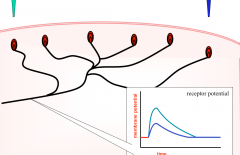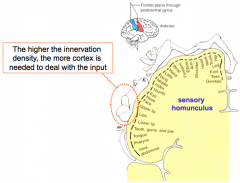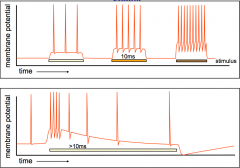![]()
![]()
![]()
Use LEFT and RIGHT arrow keys to navigate between flashcards;
Use UP and DOWN arrow keys to flip the card;
H to show hint;
A reads text to speech;
45 Cards in this Set
- Front
- Back
|
whatis the basic pathway of transmission of a stimulus |

external event -> simulates sensory receptor -> transduced into electrical signal ->AP -> information sent to CNS via a primary afferent |
|
|
the CNS has 3 main functions that sensory system is involved in. what are these |
subconscious sensory and perception arousal |
|
|
what is involved in subconscious CNS |
Control of movement autonomic responses behavioural responses Most of the information is from proprioceptors and mostimportant is the information they feed to the motor system – most of this ishappening at a subconscious level. |
|
|
how does the CNS control movement subconsciously |
- proprioceptor and vestibular input to motorpathways - nociceptor input to withdrawal reflexes |
|
|
how does the CNS control autonomic respnses subconsciously |
- olfactory input – salivation and gastricmotility - nociceptor input – flight/fight response |
|
|
how does the CNS control behavioural responses subconsciously |
- sight/smell of food – feeding behaviour - pain following injury – recuperative behaviourml> |
|
|
what pathways are involved in the CNS, Arousal system |
modulatory pathways |
|
|
what modulatory pathways are controlled by the CNS's sensory function of arousal |
SLEEP AND WAKEFULNESS- sensory input can wake a sleeper + sensory deprivation can induce sleep FOCUSING ATTENTION- concentration on one sensory modality cansuppress awareness of the others… SWITCHINGATTENTION- but a salient stimulus can recapture awareness |
|
|
what is sensation |
awareness that an event has occurred |
|
|
what is perception |
the ability toprocess and understand the information what is it, where is it, what does itmean, what should I do? |
|
|
what is meant by somatosensory |
Somatosensoryrefers to sensation that can occur anywhere in the body rather than just at asingle sense organ (e.g. sight, taste) |
|
|
what are photoreceptors |
receptors that detect light thus giving vision |
|
|
what are chemoreceptors |
receptors that can detect: chemicals in the air (so can smell) Chemicals in saliva (so can taste) inflammatory chemicals (in injury etc) |
|
|
what are mechanoreceptors |
receptors that can detect pressure on the skin such as touch receptors andinjury receptors Can detect pressure/tension/stretch in themusculoskeletal system, allowingproprioception |
|
|
what is meant by the term 'arborisation' |
a fine branching structure at the end of a nerve fibre |
|
|
due to arborisation of the skin, what is different about somatosensory receptors |
Somatosensory receptors are also the “primary afferents” Distal arbourisation of the distal axon goes up thedorsal root all the way to the brain stem |
|
|
what part of the arborised somatosensory receptor allows for reception. how does it allow AP/depolarisation/excitation |
The receptive part of this cell is a bit of membrane at thetip of these branches The membrane will have inserted into it proteinsthat are responsive to mechanical distortions of that membrane. It would happenif you pushed against the skin which would pull open channels which would allow depolarisation. |
|
|
which two systems in the body do we find the combined receptor and afferent system?
|
somatosensory system olfactory system |
|
|
The main axon splits into many aborisations so one nerve covers a larger area. due to this, we get graded electrotonic potentials. what do we mean by this |
Graded potentials are changes in membrane potential that vary in size, as opposed to being all-or-none. They arise from the summation of the individual actions of ligand-gated ion channel proteins, and decrease over time and space. if the summative electrotonic potentials are depolarised enough to bring the main axon up to threshold then youwill get an action potential. |
|
|
what is the benefit of having somatosensory receptors (aborisations) |
they are resilient to injury Theafferents are going to our skin and every time the skin is cut we cut theafferents However thelost endings can regrow (which is why feeling returns), it should actually growback to the same place and restoring sensation |
|
|
what is the disadvantage of having omatosensory receptors (aborisations) |
sensation is detected by the axon so, sensation felt is quite primitive it is achieved by mechanical distortions of the membrane as opposed to other sensory systems, where the receptors are specialised cells (much more complex) |
|
|
how does the majority of the sensory system detect sensation |
the receptorsare separate specalised cells. These cells communicate with the afferents viaexcitatory synapses. |
|
|
how do specialised cells send afferents to the CNS |
The separatecells will produce receptor potentials, causing release of glutamate This willbind to the post-synaptic afferent and cause an excitatory post synapticpotential. this may produce an action potential. |
|
|
what is the advantage of somatosensory receptors over typical sensory receptors |
Unlike somatosensory aborisation where we grew back the axon, separate receptors are delicate andirreplaceable. In other words if the receptors are damaged or die, then theywill not be replaced. |
|
|
how may photoreceptors become damaged |
destroyed bylight damage, genetic mutations, metabolic disease and malnourishment (e.g. VitA deficiency). |
|
|
how may auditory hair cells become damaged |
can bedestroyed by noise trauma , genetic mutations & ototoxicity (property ofbeing toxic to the ear, e.g. chemotherapy agents, aminoglycoside antibiotics) |
|
|
A potentialpositive of this separation of receptor and afferent is the fact that if thereceptors die the afferents may still be intact. why may this be clinically useful |
if we areartificially able to gather information from the environment and stimulate theintact afferent with a pattern of stimulation like the original receptorwould’ve done then you can restore sensation. This is becausethe brain will reconstruct the incoming afferent APs as if they had come from areceptor. |
|
|
what is the 'receptive field' of an axon |

for any ONEafferent there will be a region of the skin (called the receptive field) overwhich a single axon will have multiple nerve endings that summate to produce bigger depolarisation |
|
|
what is two point discrimination
|
ability to tell apart to different stimuli on the skin |
|
|
why is two point discrimination different on the upper arm and back |
thereceptive fields are larger here Ultimately allthe signals will be brought together to oneaxon which will summate the info and send it to the brain, this will losethe fine detail and just get the info for the region. |
|
|
smaller receptive fields = higher innervation density how would this be seen in the sensory homunculus |

|
|
|
what is meant by temporal resolution |
precisionof measurement with respect to time |
|
|
how is temporal resolution limited |
If we poked theskin twice in rapid succession, the two signals produced by the receptor ‘rideon top of each other’ so that it may feel like a single tap. summative receptor potential |
|
|
Wecan only perceive things that get above perceptual threshold. Perceptual threshold is composed ofthree different types of threshold. what are these |
Actionpotential threshold 'activation' threshold 'perceptual' threshold |
|
|
what is meant by the action potential threshold |
the membrane potential at which actionpotentials are triggered. (-55mV) This is a function of the vgNa+ channel and can betreated as a constant |
|
|
what is meant by the activation threshold |
theminimum stimulus strength needed to get to AP threshold Sensory systems use receptors with a range of differentactivation thresholds. activationthreshold is the measure of sensitivity of the axon, how easy it is todepolarise. |
|
|
what is meant by the perceptual threshold |
isthe point at which an individual can reliably detect a stimulus. It is theminimum stimulus strength needed that will generate enough APs to be noticed bythe person. Perceptual threshold is the bit we can most easily test in a clinicalenvironment. |
|
|
activation potential relies on low thresholdmechanoreceptors and high threshold mechanoreceptors. what does this mean |
The actionpotential threshold is the same (-50mV) for both, but the low thresholdmechanoreceptors are simply more sensitive so you only require gentlestimulation to get them to reach AP. |
|
|
how do Sensory systems “adapt” to constant stimuli |

in the periphery, constant signals are stripped to avoid the sytem saturating. Pressing against receptive endings gently, more strongly andthen more strongly again is shown in the top graph. Gently there is a littlebit of depolarisation and low frequency action potentials firing, and this getsmore as you press harder. if you have the same stimulus lasting longer than a few seconds, theinitial response is to how hard you press, but if you maintain this pressurethe receptor will reset itself to its original, so now it can respond equallystrongly to a new change. This avoids the receptor reaching its maximum frequency offiring. |
|
|
why do sensory systems adapt to constant stimuli?
|
·adaptation means that receptors respond to changes in stimulation over time · adaptation allows much greater sensitivity whileavoiding “saturation” ·and saves the expense of unnecessary actionpotentials |
|
|
what is lateral inhibition |

there are three afferents innervating an area. they project upto the brain stem. Ifyou pressed like how is in the diagram, then most likely all three afferentswill be activated with the one in the middle being slightly more active thanthe others(Primary afferent). so the signal to the brain isnt very localised. cells takinginfo from each part of the skins sensory map try to inhibit their surroundingneighbours in order to localise the signals If the pressure against the skin is exactly the same theywill all be activated to the same extent and so produce the same amount of inhibition and each will damp down their firingrate |
|
|
what is the benefit of lateral inhibition |
· is just one of many forms of inhibition that“sculpt” sensory signals + localise signals · it means that sensory systems respond to changes in stimulation from place toplace · it allows much greater sensitivity whileavoiding “saturation” saves the expense of unnecessary potentials |
|
|
so what are the benefits of stripping a signal of its nonvital information |
ensures that sensory systems respond to changingand NOT absolute stimulus strength through adaptation and lateral inhibition itallows to: - Highlight salient features - Allow greater sensitivity while avoidingsaturation - Save the costof unnecessary action potentials |
|
|
why do we need to know about adaption of potentials and thresholds in the context of damage and disease |
-> Candifferentially affect different types of receptor -> Damageand disease will generally increase perceptual threshold (making things less easyto sense) this occurs when receptors are lost -> Howeverthere are times where damage and disease can result in lower perceptualthreshold and thus cause hypersensitivity |
|
|
why may a person feel 'phantom limbs' after amputation |
They still have afferents that grow newsensitive endings that are still attached to afferents that reach up to thepart of the brain for the arm in the cortex. This is interpreted by the brainas stimulation for that part of the arm. |

